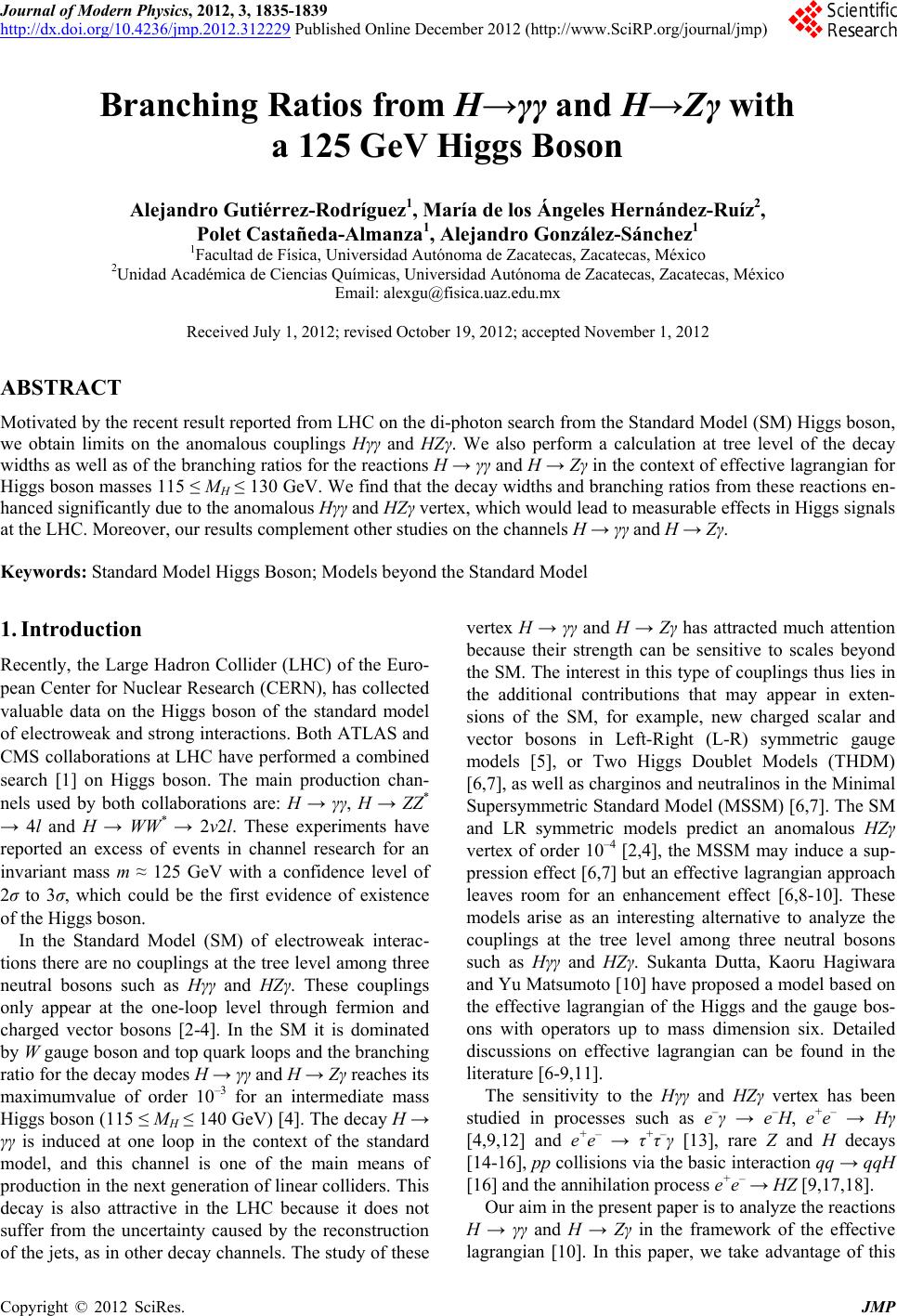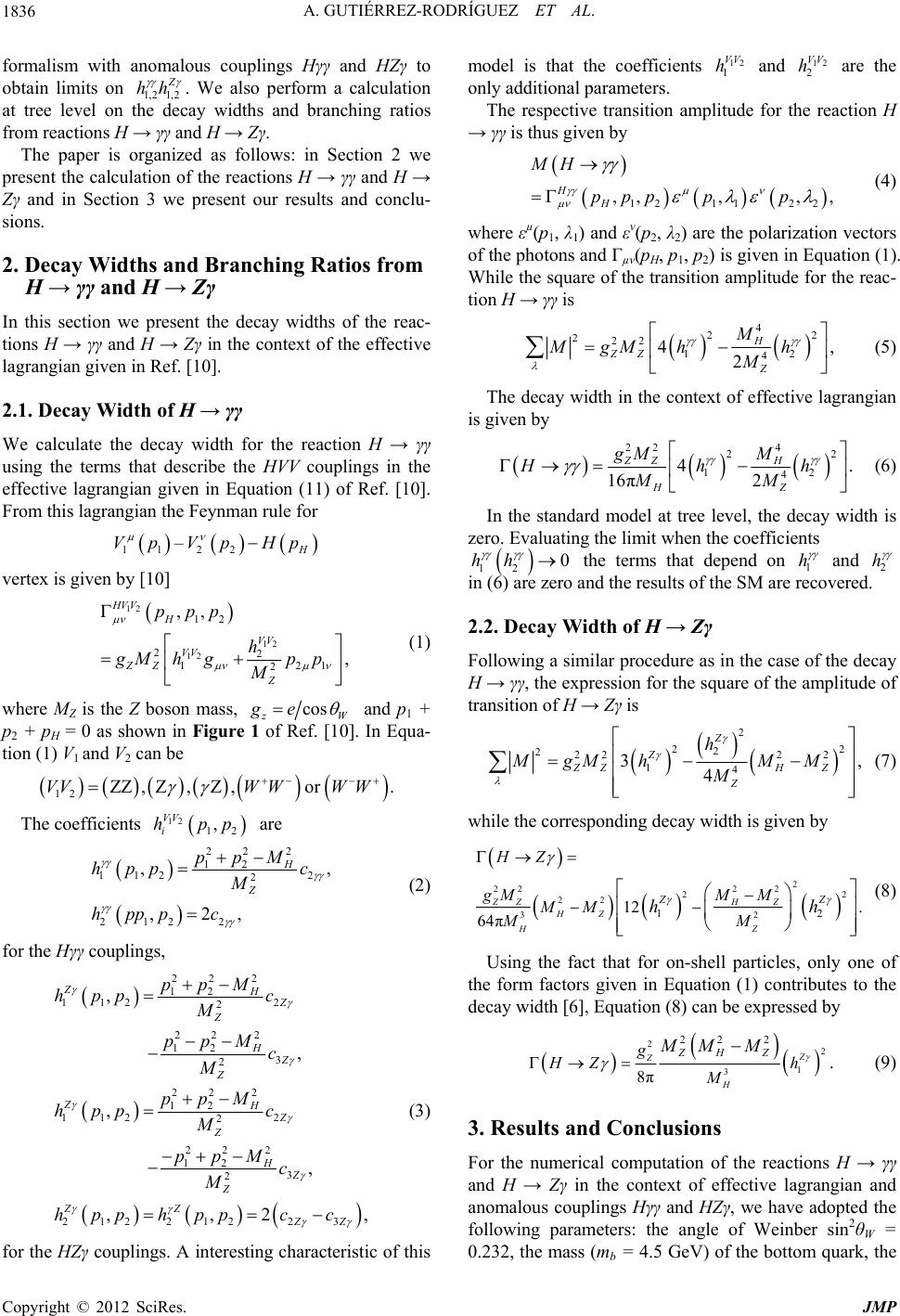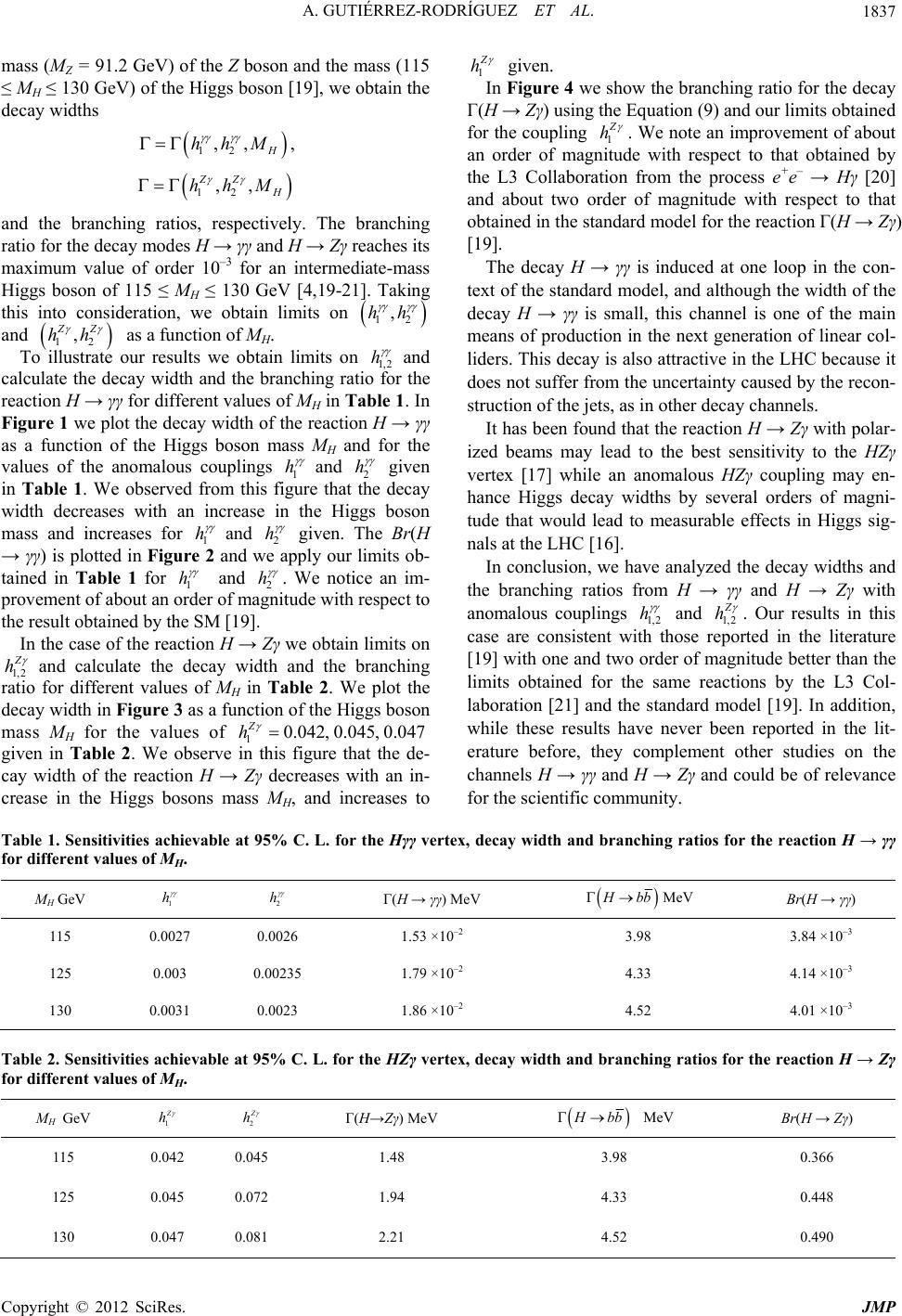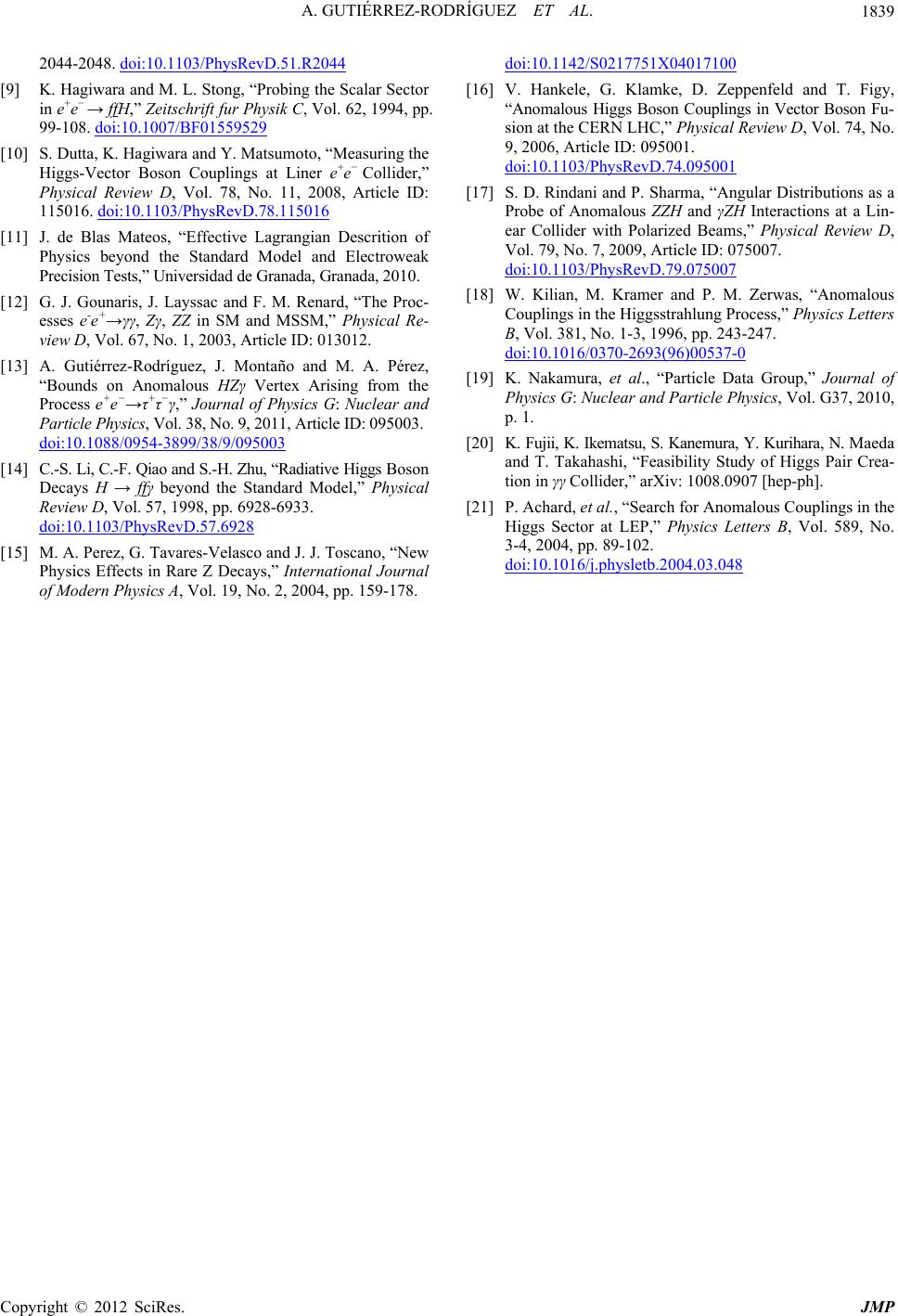 Journal of Modern Physics, 2012, 3, 1835-1839 http://dx.doi.org/10.4236/jmp.2012.312229 Published Online December 2012 (http://www.SciRP.org/journal/jmp) Branching Ratios from H→γγ and H→Zγ with a 125 GeV Higgs Boson Alejandro Gutiérrez-Rodríguez1, María de los Ángeles Hernández-Ruíz2, Polet Castañeda-Almanza1, Alejandro González-Sánchez1 1Facultad de Física, Universidad Autónoma de Zacatecas, Zacatecas, México 2Unidad Académica de Ciencias Químicas, Universidad Autónoma de Zacatecas, Zacatecas, México Email: alexgu@fisica.uaz.edu.mx Received July 1, 2012; revised October 19, 2012; accepted November 1, 2012 ABSTRACT Motivated by the recent result reported from LHC on the di-photon search from the Standard Model (SM) Higgs boson, we obtain limits on the anomalous couplings Hγγ and HZγ. We also perform a calculation at tree level of the decay widths as well as of the branching ratios for the reactions H → γγ and H → Zγ in the context of effective lagrangian for Higgs boson masses 115 ≤ MH ≤ 130 GeV. We find that the decay widths and branching ratios from these reactions en- hanced significantly due to the anomalous Hγγ and HZ γ vertex, which would lead to measurable effects in Higgs signals at the LHC. Moreover, our results complement other studies on the channels H → γγ and H → Zγ. Keywords: Standard Model Higgs Boson; Models beyond the Standard Model 1. Introduction Recently, the Large Hadron Collider (LHC) of the Euro- pean Center for Nuclear Research (CERN), has collected valuable data on the Higgs boson of the standard model of electroweak and strong interactions. Both ATLAS and CMS collaborations at LHC have performed a combined search [1] on Higgs boson. The main production chan- nels used by both collaborations are: H → γγ, H → ZZ* → 4l and H → WW* → 2ν2l. These experiments have reported an excess of events in channel research for an invariant mass m ≈ 125 GeV with a confidence level of 2σ to 3σ, which could be the first evidence of existence of the Higgs boson. In the Standard Model (SM) of electroweak interac- tions there are no couplings at the tree level among three neutral bosons such as Hγγ and HZγ. These couplings only appear at the one-loop level through fermion and charged vector bosons [2-4]. In the SM it is dominated by W gauge boson and top quark loops and the branching ratio for the decay modes H → γγ and H → Zγ reaches its maximumvalue of order 10–3 for an intermediate mass Higgs boson (115 ≤ MH ≤ 140 GeV) [4]. The decay H → γγ is induced at one loop in the context of the standard model, and this channel is one of the main means of production in the next generation of linear colliders. This decay is also attractive in the LHC because it does not suffer from the uncertainty caused by the reconstruction of the jets, as in other decay channels. The study of these vertex H → γγ and H → Zγ has attracted much attention because their strength can be sensitive to scales beyond the SM. The interest in this type of couplings thus lies in the additional contributions that may appear in exten- sions of the SM, for example, new charged scalar and vector bosons in Left-Right (L-R) symmetric gauge models [5], or Two Higgs Doublet Models (THDM) [6,7], as well as charginos and neutralinos in the Minimal Supersymmetric Standard Model (MSSM) [6,7]. The SM and LR symmetric models predict an anomalous HZγ vertex of order 10–4 [2,4], the MSSM may induce a sup- pression effect [6,7] but an effective lagrangian approach leaves room for an enhancement effect [6,8-10]. These models arise as an interesting alternative to analyze the couplings at the tree level among three neutral bosons such as Hγγ and HZγ. Sukanta Dutta, Kaoru Hagiwara and Yu Matsumoto [10] have proposed a model based on the effective lagrangian of the Higgs and the gauge bos- ons with operators up to mass dimension six. Detailed discussions on effective lagrangian can be found in the literature [6-9,11]. The sensitivity to the Hγγ and HZγ vertex has been studied in processes such as e–γ → e –H, e+e– → Hγ [4,9,12] and e+e– → τ+τ–γ [13], rare Z and H decays [14-16], pp collisions via the basic interaction qq → qqH [16] and the annihilation process e+e– → HZ [9,17,18]. Our aim in the present paper is to analyze the reactions H → γγ and H → Zγ in the framework of the effective lagrangian [10]. In this paper, we take advantage of this C opyright © 2012 SciRes. JMP  A. GUTIÉRREZ-RODRÍGUEZ ET AL. 1836 formalism with anomalous couplings Hγγ and HZγ to obtain limits on 1,2 1,2 hh 2H p Hp . We also perform a calculation at tree level on the decay widths and branching ratios from reactions H → γγ and H → Zγ. The paper is organized as follows: in Section 2 we present the calculation of the reactions H → γγ and H → Zγ and in Section 3 we present our results and conclu- sions. 2. Decay Widths and Branching Ratios from H → γγ and H → Zγ In this section we present the decay widths of the reac- tions H → γγ and H → Zγ in the context of the effective lagrangian given in Ref. [10]. 2.1. Decay Width of H → γγ We calculate the decay width for the reaction H → γγ using the terms that describe the HVV couplings in the effective lagrangian given in Equation (11) of Ref. [10]. From this lagrangian the Feynman rule for 11 2 –Vp V vertex is given by [10] 12 12 12 2 ,, HV V H VV ZZ ppp h gM h g 12 2 121 2, VV Z p p M (1) where MZ is the Z boson mass, cos W ge and p1 + p2 + pH = 0 as shown in Figure 1 of Ref. [10]. In Equa- tion (1) V1 and V2 can be or .W W 12 12 , VV i hpp 12 ZZ ,Z,Z ,VVW W The coefficients are 11 2 212 ,2 pp hp p hppp c 22 2 12 2 2 2 ,, , H Z M c M (2) for the Hγγ couplings, 22 2 12 112 2 22 12 2 22 2 12 112 2 22 12 2 212 212 , , ,, ZH Z H Z ZH Z H Z ZZ ppM hpp M ppM M ppM hpp M ppM M hpp hpp 2 2 3 2 2 3 2 3 , , 2, Z Z Z Z ZZ c c c c c c 12 1 VV h12 2 VV h (3) for the HZγ couplings. A interesting characteristic of this model is that the coefficients and are the only additional parameters. The respective transition amplitude for the reaction H → γγ is thus given by 1211 22 ,,,, , H H MH ppp pp (4) where εµ(p1, λ1) and εν(p2, λ2) are the polarization vectors of the photons and Γµν(pH, p1, p2) is given in Equation (1). While the square of the transition amplitude for the reac- tion H → γγ is 4 22 222 12 4 4, 2 H ZZ Z M MgM hh M (5) The decay width in the context of effective lagrangian is given by 22 4 22 12 4 4. 16 π2 ZZ H HZ gM M Hhh MM (6) In the standard model at tree level, the decay width is zero. Evaluating the limit when the coefficients 0hh h 12 the terms that depend on 1 h and 2 in (6) are zero and the results of the SM are recovered. 2.2. Decay Width of H → Zγ Following a similar procedure as in the case of the decay H → γγ, the expression for the square of the amplitude of transition of H → Zγ is 2 22 2 2222 2 14 3, 4 Z Z ZZH Z Z h MgM hMM M (7) while the corresponding decay width is given by 2 222 2 22 22 32 12 12 . 64π ZZH Z HZ HZ ZZ HZ gMM M MM MM hh (8) Using the fact that for on-shell particles, only one of the form factors given in Equation (1) contributes to the decay width [6], Equation (8) can be expressed by 22 1 3 22 2 8π. Z Z H ZH Z g HZ h M MM M (9) 3. Results and Conclusions For the numerical computation of the reactions H → γγ and H → Zγ in the context of effective lagrangian and anomalous couplings Hγγ and HZγ, we have adopted the following parameters: the angle of Weinber sin2θW = 0.232, the mass (mb = 4.5 GeV) of the bottom quark, the Copyright © 2012 SciRes. JMP  A. GUTIÉRREZ-RODRÍGUEZ ET AL. Copyright © 2012 SciRes. JMP 1837 12 ,, mass (MZ = 91.2 GeV) of the Z boson and the mass (115 ≤ MH ≤ 130 GeV) of the Higgs boson [19], we obtain the decay widths hhM 12 ,, ZZ H hhM , and the branching ratios, respectively. The branching ratio for the decay modes H → γγ and H → Zγ reaches its maximum value of order 10–3 for an intermediate-mass Higgs boson of 115 ≤ MH ≤ 130 GeV [4,19-21]. Taking this into consideration, we obtain limits on 12 ,hh , ZZ hh and 12 h as a function of MH. To illustrate our results we obtain limits on 1,2 and calculate the decay width and the branching ratio for the reaction H → γγ for different values of MH in Table 1. In Figure 1 we plot the decay width of the reaction H → γγ as a function of the Higgs boson mass MH and for the values of the anomalous couplings 1 h h and 2 given in Table 1. We observed from this figure that the decay width decreases with an increase in the Higgs boson mass and increases for 1 h and 2 h given. The Br(H → γγ) is plotted in Figure 2 and we apply our limits ob- tained in Table 1 for 1 h and 2 h . We notice an im- provement of about an order of magnitude with respect to the result obtained by the SM [19]. In the case of the reaction H → Zγ we obtain limits on 1,2 h and calculate the decay width and the branching ratio for different values of MH in Table 2. We plot the decay width in Figure 3 as a function of the Higgs boson mass MH for the values of 1 given in Table 2. We observe in this figure that the de- cay width of the reaction H → Zγ decreases with an in- crease in the Higgs bosons mass MH, and increases to 0.042, Z h 0.045, 0.047 1 h given. In Figure 4 we show the branching ratio for the decay Γ(H → Zγ) using the Equation (9) and our limits obtained for the coupling 1 h . We note an improvement of about an order of magnitude with respect to that obtained by the L3 Collaboration from the process e+e– → Hγ [20] and about two order of magnitude with respect to that obtained in the standard model for the reaction Γ(H → Zγ) [19]. The decay H → γγ is induced at one loop in the con- text of the standard model, and although the width of the decay H → γγ is small, this channel is one of the main means of production in the next generation of linear col- liders. This decay is also attractive in the LHC because it does not suffer from the uncertainty caused by the recon- struction of the jets, as in other decay channels. It has been found that the reaction H → Zγ with polar- ized beams may lead to the best sensitivity to the HZγ vertex [17] while an anomalous HZγ coupling may en- hance Higgs decay widths by several orders of magni- tude that would lead to measurable effects in Higgs sig- nals at the LHC [16]. In conclusion, we have analyzed the decay widths and the branching ratios from H → γγ and H → Zγ with anomalous couplings 1,2 h and 1,2 h . Our results in this case are consistent with those reported in the literature [19] with one and two order of magnitude better than the limits obtained for the same reactions by the L3 Col- laboration [21] and the standard model [19]. In addition, while these results have never been reported in the lit- erature before, they complement other studies on the channels H → γγ and H → Zγ and could be of relevance for the scientific community. Table 1. Sensitivities achievable at 95% C. L. for the Hγγ vertex, decay width and branching ratios for the reaction H → γγ for different values of MH. MH GeV 1 h 2 h Γ(H → γγ) MeV bbMeV Br(H → γγ) 1.53 ×10–2 3.84 ×10–3 115 0.0027 0.0026 3.98 1.79 ×10–2 125 0.003 0.00235 4.33 4.14 ×10–3 1.86 ×10–2 4.52 4.01 ×10–3 130 0.0031 0.0023 Table 2. Sensitivities achievable at 95% C. L. for the HZγ vertex, decay width and branching ratios for the reaction H → Zγ for different values of MH. MH GeV 1 h 2 h Γ(H→Zγ) MeV MeV Br(H → Zγ) bb 115 0.042 0.045 1.48 3.98 0.366 125 0.045 0.072 1.94 4.33 0.448 130 0.047 0.081 2.21 4.52 0.490  A. GUTIÉRREZ-RODRÍGUEZ ET AL. 1838 Figure 1. Higgs boson decay width as a function of the Higgs boson mass MH and different values of h1,2 . Figure 2. The branching ratio for the reaction H → γγ as a function of the Higgs boson mass MH and different values of h1,2 . Figure 3. Higgs boson decay width as a function of the Higgs boson mass MH and different values of Figure 4. The branching ratio for the reaction H → Zγ as a function of the Higgs boson mass MH and different values of h1,2 . 4. Acknowledgements We acknowledge support from CONACyT, SNI and PROMEP (México). REFERENCES [1] The ATLAS and CMS Collaboration, “Combined Stan- dard Model Higgs Boson Search with up to 2.3 bf-1 of pp Collisions at = 7 TeV at the LHC,” ATLAS-CONf- 2011-157, CMSPAS-HIG-11-023. [2] J. R. Ellis, M. K. Gaillard and D. V. Nanopoulos, “A Phenomenological Profile of the Higgs Boson,” Nuclear Physics B, Vol. 106, No. 2, 1976, pp. 292-340. doi:10.1016/0550-3213(76)90184-X [3] J. F. Gunion, G. L. Kane and J. Wudka, “Search Tech- niques for Charged and Neutral Intermediate Mass Higgs Bosons,” Nuclear Physics B, Vol. 299, No. 2, 1988, pp. 231-278. doi:10.1016/0550-3213(88)90284-2 [4] U. Cotti, J. L. Diaz-Cruz and J. J. Toscano, “Exact For- mulae for Higgs Production through eγ → eH in the Nonlinear R(ξ) Gauge,” Physics Letters B, Vol. 404, No. 3-4, 1997, pp. 308-314. doi:10.1016/S0370-2693(97)00590-X [5] R. Martinez, M. A. Perez and J. J. Toscano, “The Two Photon Decay Width of the Higgs Boson in Left-right Symmetric Theories,” Physical Review D, Vol. 40, No. 5, 1989, pp. 1722-1724. doi:10.1103/PhysRevD.40.1722 [6] A. Djouadi, V. Driesen, W. Hollik and A. Kraft, “The Higgs Photon-Z Boson Coupling Revisited,” The Euro- pean Physical Journal C, Vol. 1, No. 1-2, 1998, pp. 163- 175. doi:10.1007/BF01245806 [7] T. G. Rizzo, “Probing the WHZ Vertex in E(6) Models at Colliders,” Physical Review D, Vol. 39, No. 3, 1989, pp. 728-735. doi:10.1103/PhysRevD.39.728 [8] J. M. Hernandez, M. A. Perez and J. J. Toscano, “Decays H0 → γγ,γZ, and Z → γH0 in the Effective Lagrangian Approach,” Physical Review D, Vol. 51, No. 5, 1995, pp. h1,2 . Copyright © 2012 SciRes. JMP  A. GUTIÉRREZ-RODRÍGUEZ ET AL. 1839 2044-2048. doi:10.1103/PhysRevD.51.R2044 [9] K. Hagiwara and M. L. Stong, “Probing the Scalar Sector in e+e− → ffH,” Zeitschrift fur Physik C, Vol. 62, 1994, pp. 99-108. doi:10.1007/BF01559529 [10] S. Dutta, K. Hagiwara and Y. Matsumoto, “Measuring the Higgs-Vector Boson Couplings at Liner e+e− Collider,” Physical Review D, Vol. 78, No. 11, 2008, Article ID: 115016. doi:10.1103/PhysRevD.78.115016 [11] J. de Blas Mateos, “Effective Lagrangian Descrition of Physics beyond the Standard Model and Electroweak Precision Tests,” Universidad de Granada, Granada, 2010. [12] G. J. Gounaris, J. Layssac and F. M. Renard, “The Proc- esses e-e+→γγ, Zγ, ZZ in SM and MSSM,” Physical Re- view D, Vol. 67, No. 1, 2003, Article ID: 013012. [13] A. Gutiérrez-Rodríguez, J. Montaño and M. A. Pérez, “Bounds on Anomalous HZγ Vertex Arising from the Process e+e−→τ+τ−γ,” Journal of Physics G: Nuclear and Particle Physics, Vol. 38, No. 9, 2011, Article ID: 095003. doi:10.1088/0954-3899/38/9/095003 [14] C.-S. Li, C.-F. Qiao and S.-H. Zhu, “Radiative Higgs Boson Decays H → ffγ beyond the Standard Model,” Physical Review D, Vol. 57, 1998, pp. 6928-6933. doi:10.1103/PhysRevD.57.6928 [15] M. A. Perez, G. Tavares-Velasco and J. J. Toscano, “New Physics Effects in Rare Z Decays,” International Journal of Modern Physics A, Vol. 19, No. 2, 2004, pp. 159-178. doi:10.1142/S0217751X04017100 [16] V. Hankele, G. Klamke, D. Zeppenfeld and T. Figy, “Anomalous Higgs Boson Couplings in Vector Boson Fu- sion at the CERN LHC,” Physical Review D, Vol. 74, No. 9, 2006, Article ID: 095001. doi:10.1103/PhysRevD.74.095001 [17] S. D. Rindani and P. Sharma, “Angular Distributions as a Probe of Anomalous ZZH and γZH Interactions at a Lin- ear Collider with Polarized Beams,” Physical Review D, Vol. 79, No. 7, 2009, Article ID: 075007. doi:10.1103/PhysRevD.79.075007 [18] W. Kilian, M. Kramer and P. M. Zerwas, “Anomalous Couplings in the Higgsstrahlung Process,” Physics Letters B, Vol. 381, No. 1-3, 1996, pp. 243-247. doi:10.1016/0370-2693(96)00537-0 [19] K. Nakamura, et al., “Particle Data Group,” Journal of Physics G: Nuclear and Particle Physics, Vol. G37, 2010, p. 1. [20] K. Fujii, K. Ikematsu, S. Kanemura, Y. Kurihara, N. Maeda and T. Takahashi, “Feasibility Study of Higgs Pair Crea- tion in γγ Collider,” arXiv: 1008.0907 [hep-ph]. [21] P. Achard, et al., “Search for Anomalous Couplings in the Higgs Sector at LEP,” Physics Letters B, Vol. 589, No. 3-4, 2004, pp. 89-102. doi:10.1016/j.physletb.2004.03.048 Copyright © 2012 SciRes. JMP
|